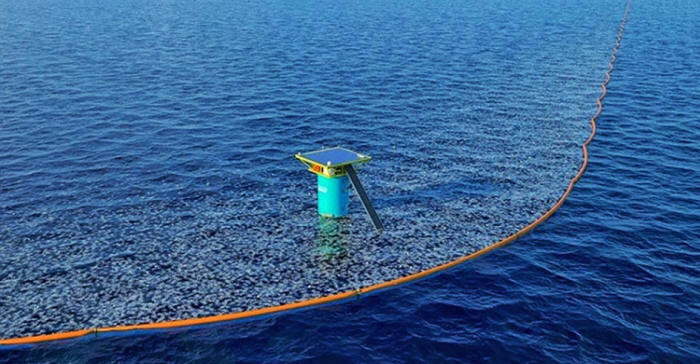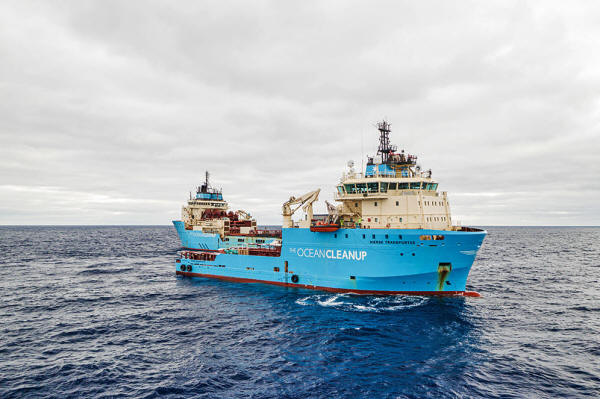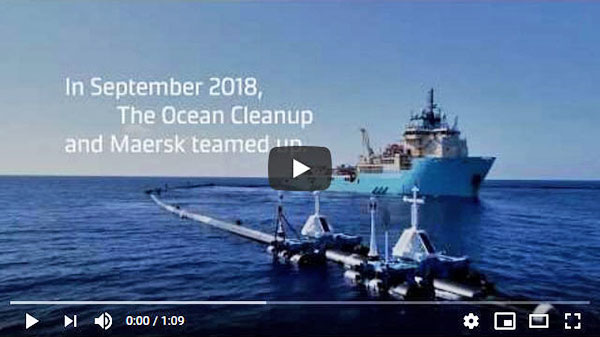|

by Elias Marat
October
03, 2019
from
TheMindUnleashed Website

In a
historical first,
a giant floating
machine
designed to
clean up plastic from the ocean
is collecting
trash from the
Great Pacific
Garbage Patch...
In a historical first, a
massive floating device designed by conservationists to clean up
plastic from the ocean has successfully collected trash from the
Great Pacific Garbage Patch.
The machine, which was invented by 25-year-old Dutch inventor and
engineer Boyan Slat, consists of a huge line of cork floats
holding a huge skirt that traps the garbage below.
On Wednesday, The Ocean Cleanup
announced that the system was able
to capture and hold trash ranging from visible plastic debris to
large abandoned fishing gear known as "ghost nets" - and even tiny
microplastics as small as 1
millimeter.

In the statement, Slat said:
"After beginning this
journey seven years ago, this first year of testing in the
unforgivable environment of the high seas strongly indicates
that our vision is attainable and that the beginning of our
mission to rid the ocean of plastic garbage, which has
accumulated for decades, is within our sights.
Our team has remained steadfast in its determination to solve
immense technical challenges to arrive at this point.
Though we still have
much more work to do, I am eternally grateful for the team's
commitment and dedication to the mission and look forward to
continuing to the next phase of development."
https://twitter.com/TheOceanCleanup/status/1179430600337428482
Launched from Vancouver in June,
The Ocean Cleanup Project's
high-tech
System 001/B is fitted with a variety of devices such as,
-
solar-powered lights
-
sensors
-
cameras
-
satellite antennae,
...that
allow The Ocean Cleanup to keep tabs on it via GPS while also
using a dedicated support vessel to collect the trapped plastic
every few months before bringing it back to dry land.

System 001/B simulates a coastline and uses the ocean's force to
trap the countless pieces of plastic debris estimated to be swirling
around in the patch.
Marine life is able to safely swim around the gigantic boom and,
according to marine biologists who have tracked the system, no
adverse environmental impact has resulted from the system's
deployment.
Slat said in a tweet that the system, along with its support vessel,
is now in transit to port for a crew change and will resume
collecting garbage on October 17 (2019).
https://twitter.com/BoyanSlat/status/1179836477104099328
In 1997, ocean researcher
Charles J. Moore discovered the Great Pacific
Garbage Patch, which has now grown to become the largest
accumulation zone of plastic in the world's ocean.
Years later, he
told CBS
News that plastics are a leading cause of environmental devastation
across the world, adding:
"Humanity's plastic
footprint is probably more dangerous than its carbon footprint."
In recent years, experts
and conservationists have sounded the alarm over the plastics and
microplastics that are
inundating the world's oceans and water
supplies, leaching carcinogenic toxins and chemicals into the marine
environment...
In the meantime, plastic
drink containers and trash used by fishers are trapping, confining,
and ultimately killing marine wildlife such as birds and fish.
Plastic pollution has reached such massive proportions that an
estimated 100 million tons of it can now be found in the world's
oceans, according to the UN, devastating such industries as tourism
and fishing while embedding itself on all levels of the food chain.
Between 80 and 90 percent
of plastic waste in the ocean comes from land-based sources.
And according to a report
(The
New Plastics Economy - Rethinking the Future of Plastics)
prepared for the 2016 World Economic Forum in Davos,
Switzerland, by 2050 it is estimated that plastic waste in the ocean
will outweigh all fish.
https://twitter.com/ValaAfshar/status/1179222355798843393
| 



